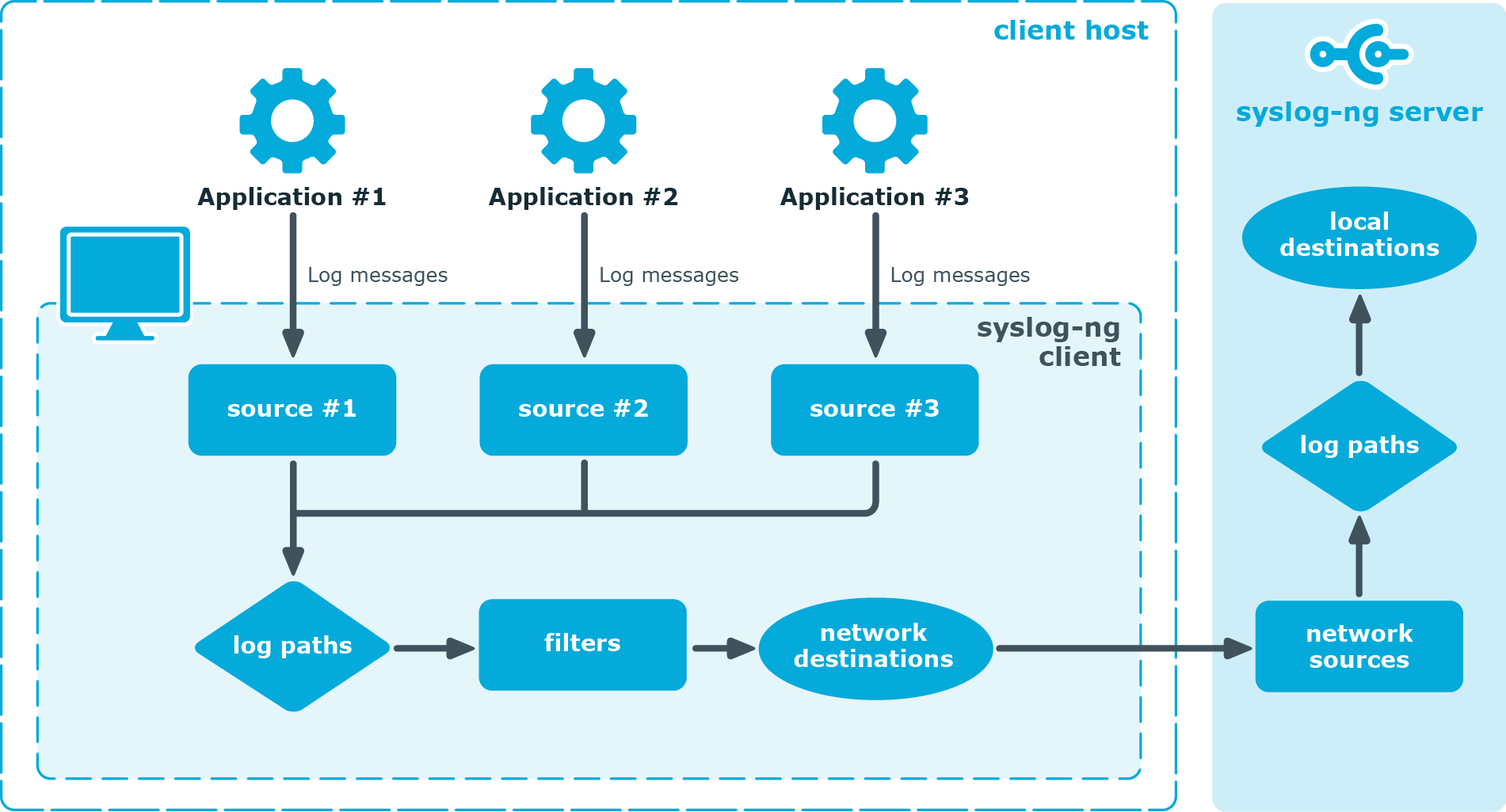Logging with syslog-ng
The syslog-ng OSE application reads incoming messages and forwards them to the selected destinations. The syslog-ng OSE application can receive messages from files, remote hosts, and other sources.
Log messages enter syslog-ng OSE in one of the defined sources, and are sent to one or more destinations.
Sources and destinations are independent objects, log paths define what syslog-ng OSE does with a message, connecting the sources to the destinations. A log path consists of one or more sources and one or more destinations: messages arriving from a source are sent to every destination listed in the log path. A log path defined in syslog-ng OSE is called a log statement.
Optionally, log paths can include filters. Filters are rules that select only certain messages, for example, selecting only messages sent by a specific application. If a log path includes filters, syslog-ng sends only the messages satisfying the filter rules to the destinations set in the log path.
Other optional elements that can appear in log statements are parsers and rewriting rules. Parsers segment messages into different fields to help processing the messages, while rewrite rules modify the messages by adding, replacing, or removing parts of the messages.
The route of a log message in syslog-ng
Purpose
The following procedure illustrates the route of a log message from its source on the syslog-ng OSE client to its final destination on the central syslog-ng OSE server.
Figure 1: The route of a log message

Steps
-
A device or application sends a log message to a source on the syslog-ng OSE client. For example, an Apache web server running on Linux enters a message into the /var/log/apache file.
-
The syslog-ng OSE client running on the web server reads the message from its /var/log/apache source.
-
The syslog-ng OSE client processes the first log statement that includes the /var/log/apache source.
-
The syslog-ng OSE client performs optional operations (message filtering, parsing, and rewriting) on the message, for example, it compares the message to the filters of the log statement (if any). If the message complies with all filter rules, syslog-ng OSE sends the message to the destinations set in the log statement, for example, to the remote syslog-ng OSE server.
 CAUTION: Message
filtering, parsing, and rewriting is performed in the order that the
operations appear in the log statement.
CAUTION: Message
filtering, parsing, and rewriting is performed in the order that the
operations appear in the log statement.NOTE: The syslog-ng OSE client sends a message to all matching destinations by default. As a result, a message may be sent to a destination more than once, if the destination is used in multiple log statements. To prevent such situations, use the final flag in the destination statements. For details, see Log path flags.
-
The syslog-ng OSE client processes the next log statement that includes the /var/log/apache source, repeating steps 3-4.
-
The message sent by the syslog-ng OSE client arrives from a source set in the syslog-ng OSE server.
-
The syslog-ng OSE server reads the message from its source and processes the first log statement that includes that source.
-
The syslog-ng OSE server performs optional operations (message filtering, parsing, and rewriting) on the message, for example, it compares the message to the filters of the log statement (if any). If the message complies with all filter rules, syslog-ng OSE sends the message to the destinations set in the log statement.
 CAUTION: Message filtering,
parsing, and rewriting is performed in the order that the operations appear
in the log statement.
CAUTION: Message filtering,
parsing, and rewriting is performed in the order that the operations appear
in the log statement. -
The syslog-ng OSE server processes the next log statement, repeating steps 7-9.
NOTE: The syslog-ng OSE application can stop reading messages from its sources if the destinations cannot process the sent messages. This feature is called flow-control and is detailed in Managing incoming and outgoing messages with flow-control.